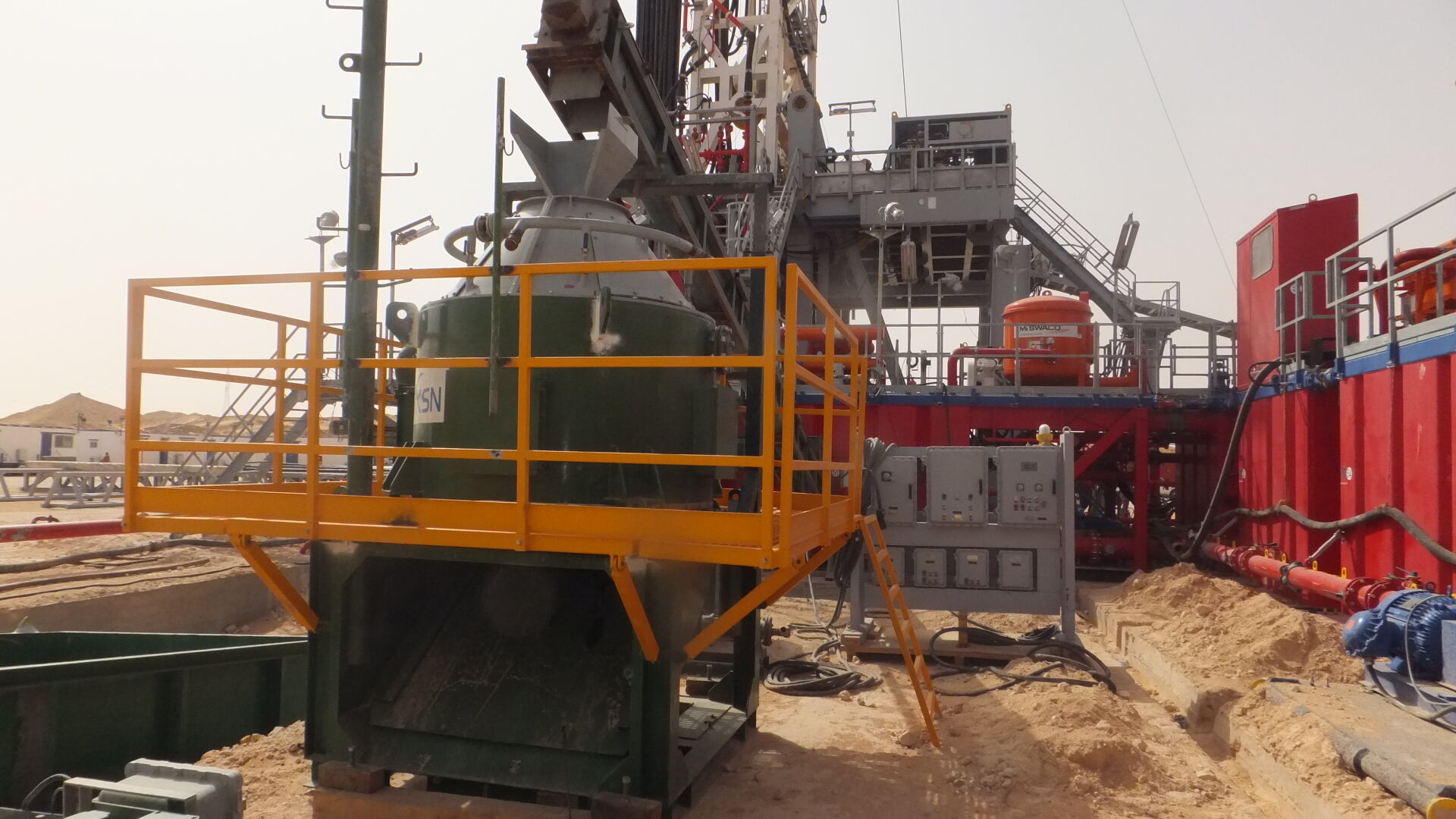ຍຸດທະສາດພື້ນຖານສຳລັບການຈັດການ ການຈັດການຂີ້ໜູນການເຊົ້າ
ອຸດສະຫະກຳນ້ຳມັນແລະກັດແຂ້ວກຳລັງປະເຊີນກັບຄວາມກົດດັນທີ່ເພີ່ມຂື້ນໃນການຈັດການ ສິ່ງເສຍທີ່ເກີດຈາກການຂຸດເຈາະ ຢ່າງຮັບຜິດຊອບໃນຂະນະທີ່ຍັງຮັກສາປະສິດທິພາບໃນການດຳເນີນງານໄວ້ໄດ້. ການຈັດການຂີ້ເຫຍື້ອຈາກການຂຸດເຈາະກວມເອົາການຈັດການແບບຄົບຖ້ວນເຖິງຂັ້ນຕອນການກຳຈັດ, ການປິ່ນປົວ, ແລະ ການຖິ້ມວັດຖຸທີ່ເກີດຂື້ນໃນຂະນະກຳລັງຂຸດເຈາະ. ຈາກສ່ວນທີ່ຖືກຕັດອອກຈາກການຂຸດເຈາະຈົນເຖິງນ້ຳຢາຂຸດເຈາະທີ່ໃຊ້ແລ້ວ, ການຈັດການວັດຖຸເຫຼົ່ານີ້ໃຫ້ຖືກຕ້ອງແມ່ນມີຄວາມສຳຄັນຫຼາຍຕໍ່ການປົກປ້ອງສິ່ງແວດລ້ອມ, ການປະຕິບັດຕາມລະບຽບກົດໝາຍ, ແລະ ການດຳເນີນງານຢ່າງຍືນຍົງ.
ການຈັດການຂີ້ເຫຍື້ອຈາກການຂຸດເຈາະທີ່ທັນສະໄໝໄດ້ພັດທະນາຢ່າງຫຼວງຫຼາຍ, ລວມເອົາເອົາເຕັກໂນໂລຊີຂັ້ນສູງ ແລະ ວິທີແກ້ໄຂທີ່ຄິດສ້າງສັນທີ່ຫຼຸດຜ່ອນຜົນກະທົບຕໍ່ສິ່ງແວດລ້ອມໃນຂະນະທີ່ເພີ່ມປະສິດທິພາບດ້ານຕົ້ນທຶນ. ໃນຂະນະທີ່ຂໍ້ກໍານົດດ້ານສິ່ງແວດລ້ອມມີຄວາມເຂັ້ມງວດຫຼາຍຂຶ້ນໃນທົ່ວໂລກ, ບໍລິສັດຕ່າງໆຕ້ອງຮັບເອົາເອົາວິທີປະຕິບັດທີ່ດີທີ່ສຸດທີ່ພິສູດແລ້ວເພື່ອຮັບປະກັນການຈັດການຂີ້ເຫຍື້ອຢ່າງຮັບຜິດຊອບຕະຫຼອດວົງຈອນການຂຸດເຈາະ.

ອົງປະກອບຫຼັກຂອງລະບົບການຈັດການຂີ້ເຫຍື້ອຈາກການຂຸດເຈາະ
ການກໍານົດຄຸນລັກສະນະ ແລະ ການປະເມີນຂີ້ເຫຍື້ອ
ກ່ອນຈະດໍາເນີນການຍຸດທະສາດໃດໆ, ການກໍານົດຄຸນລັກສະນະຂອງຂີ້ເຫຍື້ອຢ່າງລະອຽດແມ່ນມີຄວາມສໍາຄັນຫຼາຍ. ຂະບວນການນີ້ລວມເຖິງການວິເຄາະຄຸນສົມບັດທາງດ້ານຮ່າງກາຍ ແລະ ເຄມີຂອງສາຍຂີ້ເຫຍື້ອຈາກການຂຸດເຈາະເພື່ອກໍານົດຜົນກະທົບຕໍ່ສິ່ງແວດລ້ອມທີ່ອາດເກີດຂຶ້ນ ແລະ ວິທີການປິ່ນປົວທີ່ເໝາະສົມ. ການເກັບຕົວຢ່າງ ແລະ ການທົດສອບຢ່າງສະໝໍ່າສະເໝີຊ່ວຍໃນການເບິ່ງວ່າມີອົງປະກອບອັນຕະລາຍ ແລະ ຊີ້ນໍາໃຫ້ຮູ້ເຖິງຂັ້ນຕອນການຈັດການທີ່ເໝາະສົມ.
ວິທີການວິເຄາະຂັ້ນສູງເຮັດໃຫ້ສາມາດກໍານົດສ່ວນປະກອບຂອງຂີ້ເຫຍື້ອໄດ້ຢ່າງແນ່ນອນ ເຊິ່ງຊ່ວຍໃຫ້ຜູ້ປະກອບການສາມາດພັດທະນາວິທີແກ້ໄຂໃນການປຸງແຕ່ງທີ່ມີເປົ້າໝາຍ. ວິທີການນີ້ຮັບປະກັນຄວາມສອດຄ່ອງກັບຂໍ້ກໍານົດດ້ານສິ່ງແວດລ້ອມ ໃນຂະນະທີ່ເພີ່ມປະສິດທິພາບໃນການປຸງແຕ່ງ ແລະ ຫຼຸດຜ່ອນຕົ້ນທຶນການດໍາເນີນງານ.
ເຕັກໂນໂລຊີການປຸງແຕ່ງ ແລະ ວິທີການດໍາເນີນການ
ການຈັດການຂີ້ເຫຍື້ອຈາກການຂຸດເຈາະໃນຍຸກທັນສະໄໝ ນໍາໃຊ້ເຕັກໂນໂລຊີການປຸງແຕ່ງຕ່າງໆ ເຊິ່ງແຕ່ລະຢ່າງເໝາະສົມກັບປະເພດຂີ້ເຫຍື້ອ ແລະ ສະພາບແວດລ້ອມທີ່ແຕກຕ່າງກັນ. ລະບົບການປຸງແຕ່ງດ້ວຍຄວາມຮ້ອນ ສາມາດຫຼຸດຜ່ອນປະລິມານຂີ້ເຫຍື້ອ ແລະ ກູ້ຄືນສ່ວນປະກອບທີ່ມີຄ່າ, ໃນຂະນະທີ່ວິທີການປັບປຸງດ້ວຍເຄມີສາດເຮັດໃຫ້ວັດຖຸອັນຕະລາຍບໍ່ສາມາດເຮັດປະຕິກິລິຍາໄດ້. ຕົວເລືອກໃນການປຸງແຕ່ງດ້ວຍຊີວະພາບ ສະເໜີວິທີແກ້ໄຂທີ່ຍືນຍົງສໍາລັບການຈັດການຂີ້ເຫຍື້ອທີ່ສາມາດຍ່ອຍສະຫຼາຍໄດ້.
ເຄື່ອງຈັກດໍາເນີນການທີ່ທັນສະໄໝ ລວມທັງເຄື່ອງຫຼຸດສະພາບນ້ໍາໜັກດ້ວຍສູນຍາກາດ, ເຄື່ອງຖອນຄວາມຮ້ອນ, ແລະ ລະບົບຟື້ນຟູດ້ວຍຊີວະພາບ ແມ່ນມີບົດບາດສໍາຄັນໃນການບັນລຸເປົ້າໝາຍການຫຼຸດຜ່ອນຂີ້ເຫຍື້ອ. ເຕັກໂນໂລຊີເຫຼົ່ານີ້ຍັງສືບຕໍ່ການພັດທະນາ ເຊິ່ງສະເໜີປະສິດທິພາບທີ່ດີຂື້ນ ແລະ ສົ່ງຜົນກະທົບຕໍ່ສິ່ງແວດລ້ອມໜ້ອຍລົງ.
ບັນຫາດ້ານສິ່ງແວດລ້ອມ ແລະ ການປະຕິບັດຕາມລະບຽບກົດໝາຍ
ການສັງເສີດຜົນກະທົບຕໍ່ສິ່ງແວດล້ອມ
ການປະເມີນຜົນກະທົບຕໍ່ສິ່ງແວດລ້ອມຢ່າງລະອອຍເປັນພື້ນຖານຂອງການຈັດການຂີ້ເຫຍື້ອໃນການຂຸດເຈາະຢ່າງຮັບຜິດຊອບ. ການປະເມີນຜົນເຫຼົ່ານີ້ຈະປະເມີນຜົນກະທົບທີ່ອາດເກີດຂຶ້ນຕໍ່ດິນ, ແຫຼ່ງນ້ຳ, ຄຸນນະພາບອາກາດ ແລະ ລະບົບນິເວດທ້ອງຖິ່ນ. ໂຄງການຕິດຕາມສິ່ງແວດລ້ອມຢ່າງຕໍ່ເນື່ອງຈະຕິດຕາມຄ່າຕ່າງໆຂອງສິ່ງແວດລ້ອມ ແລະ ປະກັນວ່າມີການຈັດການທີ່ຮັກສາຄວາມສົມດຸນຂອງລະບົບນິເວດໄວ້ໄດ້.
ເຄື່ອງມືຈຳລອງທີ່ທັນສະໄໝຊ່ວຍຄາດຄະເນຜົນກະທົບຕໍ່ສິ່ງແວດລ້ອມໃນໄລຍະຍາວ ແລະ ຊີ້ນຳຍຸດທະສາດການຈັດການ. ວິທີການເຊິ່ງໜ້ານີ້ຊ່ວຍໃຫ້ບໍລິສັດຫຼີກລ່ຽງຄ່າໃຊ້ຈ່າຍໃນການຟື້ນຟູທີ່ອາດຈະສູງເກີນໄປ ໃນຂະນະທີ່ຮັກສາຊັບພະຍາກອນທຳມະຊາດ ແລະ ຮັກສາຄວາມສຳພັນທີ່ດີກັບຊຸມຊົນທ້ອງຖິ່ນໄວ້ໄດ້.
ກອບກົດໝາຍ ແລະ ຍຸດທະສາດການປະຕິບັດຕາມ
ວິທີການຄຸ້ມຄອງຂີ້ເຫຍື້ອໃນການຂຸດເຈາະຍັງຄົງມີການປ່ຽນແປງຢູ່ເລື້ອຍໆ ດ້ວຍການເນັ້ນໜັກໃສ່ການປົກປ້ອງສິ່ງແວດລ້ອມ ແລະ ການປະຕິບັດຢ່າງຍືນຍົງ. ຍຸດທະສາດໃນການປະຕິບັດຕາມທີ່ປະສົບຜົນສຳເລັດ ຈຳເປັນຕ້ອງເຂົ້າໃຈຢ່າງລະອຽດກ່ຽວກັບຂໍ້ກຳນົດຂອງທ້ອງຖິ່ນ, ຂັ້ນແຂວງ ແລະ ລະດັບສາກົນ. ບໍລິສັດຈຳເປັນຕ້ອງຮັກສາເອກະສານ ແລະ ລະບົບການລາຍງານໃຫ້ຄົບຖ້ວນເພື່ອສະແດງໃຫ້ເຫັນເຖິງການປະຕິບັດຕາມຂໍ້ກຳນົດ.
ການກວດສອບ ແລະ ອັບເດດເປັນປະຈຳຕໍ່ວິທີການຄຸ້ມຄອງ ຈະຮັບປະກັນໃຫ້ມີການປະຕິບັດຕາມຢ່າງຕໍ່ເນື່ອງ ແລະ ສາມາດຄົ້ນຫາໂອກາດໃນການປັບປຸງໄດ້. ການສ້າງຄວາມສຳພັນທີ່ເຂັ້ມແຂງກັບອົງການຄຸ້ມຄອງ ຈະຊ່ວຍໃຫ້ການສື່ສານມີປະສິດທິພາບ ແລະ ລະບົບການປະຕິບັດຕາມມີຄວາມລຽບລຽນ.
ເຕັກນິກໃນການຫຼຸດຜ່ອນຂີ້ເຫຍື້ອຢ່າງມີປະສິດທິພາບຕໍ່າ
ຍຸດທະສາດໃນການຫຼຸດຜ່ອນຂີ້ເຫຍື້ອຕັ້ງແຕ່ຕົ້ນທາງ
ການນຳໃຊ້ຢຸດທະສາດການຫຼຸດຜ່ອນແຫຼ່ງທີ່ມີປະສິດທິພາບແມ່ນເປັນອົງປະກອບພື້ນຖານຂອງການຈັດການຂີ້ເຫຍື້ອທີ່ເກີດຈາກການຂຸດເຈາະ. ຢຸດທະສາດເຫຼົ່ານີ້ໃຫ້ຄວາມສຳຄັນໃນການຫຼຸດຜ່ອນການເກີດຂີ້ເຫຍື້ອຜ່ານການປັບປຸງວິທີການຂຸດເຈາະ, ການເລືອກນ້ຳຢາຂຸດເຈາະໃຫ້ເໝາະສົມ ແລະ ການປັບປຸງປະສິດທິພາບຂອງເຄື່ອງຈັກ. ເທກໂນໂລຊີການຂຸດເຈາະຂັ້ນສູງ, ລວມທັງບໍ່ນ້ຳທີ່ມີເສັ້ນຜ່າສູນກາງນ້ອຍລົງ ແລະ ນ້ຳຢາຂຸດເຈາະທີ່ດີຂື້ນ ສາມາດຫຼຸດຜ່ອນປະລິມານຂີ້ເຫຍື້ອໄດ້ຫຼາຍ.
ການບຳລຸງຮັກສາເຄື່ອງຈັກຢ່າງສະໝຳເສີມ ແລະ ການຝຶກອົບຮົມຜູ້ປະກອບການ ຈະຮັບປະກັນວ່າເຄື່ອງຈັກດຳເນີນງານໄດ້ຢູ່ໃນຂີດສູງສຸດ, ສົ່ງຜົນໃຫ້ຫຼຸດຜ່ອນການເກີດຂີ້ເຫຍື້ອ ແລະ ຄ່າໃຊ້ຈ່າຍໃນການດຳເນີນງານລົງ. ນະວັດຕະກຳໃນການຜະລິດນ້ຳຢາຂຸດເຈາະຍັງສືບຕໍ່ໃຫ້ມີທາງເລືອກທີ່ເປັນມິດຕໍ່ສິ່ງແວດລ້ອມ ເຊິ່ງຊ່ວຍຫຼຸດຜ່ອນຂີ້ເຫຍື້ອໃນຂະນະທີ່ຮັກສາປະສິດທິພາບໄວ້ໄດ້.
ການຮີໄຊເຄື່ອງມື ແລະ ການຟື້ນຟູຊັບພະຍາກອນ
ການຈັດການຂີ້ເຫຍື້ອທີ່ທັນສະໄໝໃນການຂຸດເຈາະໃຫ້ຄວາມສຳຄັນກັບການຮີໄຊເຄື່ອງເຫຼືອນແລະການກູ້ຄືນຊັບພະຍາກອນທຸກເທື່ອເປັນໄປໄດ້. ເທກໂນໂລຊີແຍກທີ່ທັນສະໄໝເຮັດໃຫ້ສາມາດກູ້ຄືນອົງປະກອບທີ່ມີຄຸນຄ່າຈາກການໄຫຼວຽນຂອງຂີ້ເຫຍື້ອ, ລວມທັງນ້ຳມັນ, ນ້ຳ ແລະ ວັດຖຸດິບທີ່ສາມາດນຳໃຊ້ຄືນໄດ້. ຊັບພະຍາກອນທີ່ກູ້ຄືນໄດ້ເຫຼົ່ານີ້ສາມາດນຳກັບໄປໃຊ້ໃນການດຳເນີນງານຄືນ, ລົດຕົ້ນທຶນວັດຖຸດິບ ແລະ ປະລິມານຂີ້ເຫຍື້ອທີ່ເຫຼືອ.
ໂຄງການຮີໄຊທີ່ຄິດສ້າງສັນປ່ຽນແປງວັດຖຸເຫຼືອທີ່ເໝາະສົມໃຫ້ກາຍເປັນຜະລິດຕະພັນທີ່ເປັນປະໂຫຍດ, ຕົວຢ່າງເຊັ່ນ: ວັດຖຸສຳລັບການສ້າງສິ່ງກໍ່ສ້າງ ຫຼື ປຸງແຕ່ງດິນ. ວິທີການນີ້ບໍ່ພຽງແຕ່ຊ່ວຍຫຼຸດຜ່ອນຕົ້ນທຶນໃນການຖິ້ມຂີ້ເຫຍື້ອເທົ່ານັ້ນ, ແຕ່ຍັງສ້າງຊັບພະຍາກອນເສີມເພີ່ມເຕີມຈາກຂີ້ເຫຍື້ອທີ່ເຫຼືອອີກດ້ວຍ.
ແນວໂນ້ມໃນອະນາຄົດຂອງການຈັດການຂີ້ເຫຍື້ອໃນການຂຸດເຈາະ
Innovations ອົງການ
ອະນາຄົດຂອງການຈັດການຂີ້ເຫຍື້ອໃນການຂຸດເຈາະຂຶ້ນຢູ່ກັບເທກໂນໂລຊີໃໝ່ທີ່ສັນຍາໄວ້ວ່າຈະໃຫ້ປະສິດທິພາບສູງຂຶ້ນ ແລະ ການປົກປ້ອງສິ່ງແວດລ້ອມດີຂຶ້ນ. ລະບົບປັນຍາປະດິດສ້າງ (Artificial intelligence) ແລະ ລະບົບອັດຕະໂນມັດຊ່ວຍເພີ່ມປະສິດທິພາບຂະບວນການປິ່ນປົວ ແລະ ຫຼຸດຜ່ອນຄວາມຜິດພາດຂອງມະນຸດ. ວັດຖຸດິບຂັ້ນສູງ ແລະ ວິທີການປິ່ນປົວທີ່ທັນສະໄໝຍັງດຳເນີນການປັບປຸງຄວາມສາມາດໃນການຈັດການຂີ້ເຫຍື້ອໃນຂະນະທີ່ຫຼຸດຜ່ອນຕົ້ນທຶນການດຳເນີນງານ.
ການຄົ້ນຄວ້າກ່ຽວກັບເຕັກໂນໂລຊີການປິ່ນປົວໃໝ່, ລວມທັງຂະບວນການອົກຊີເດຊັນຂັ້ນສູງ ແລະ ການນຳໃຊ້ເຕັກໂນໂລຊີແນັນ, ສະແດງໃຫ້ເຫັນຜົນໄດ້ຮັບທີ່ດີສຳລັບປະສິດທິພາບໃນການປຸງແຕ່ງຂີ້ເຫຍື້ອທີ່ດີຂື້ນ. ນະວະນິຕະກຳເຫຼົ່ານີ້ຈະຮຽກຮ້ອງໃນອະນາຄົດຂອງການຈັດການຂີ້ເຫຍື້ອທີ່ເກີດຈາກການຂຸດເຈາະ.
ການຈັດການທີ່ຍືນຍົງ
ການພັດທະນາຢ່າງຍືນຍົງຍັງຄົງເປັນແຮງຂັບເຄື່ອນໃນການປະດິດສ້າງນະວະນິຕະກຳໃນການຈັດການຂີ້ເຫຍື້ອຈາກການຂຸດເຈາະ. ບໍລິສັດຕ່າງໆນຳໃຊ້ຫຼັກການເສດຖະກິດແບບວົງຈອນເພີ່ມຂື້ນ, ສຳຫຼວດຫາວິທີການທີ່ຈະຂັດເກລີຍຂີ້ເຫຍື້ອ ແລະ ປັບປຸງປະສິດທິພາບໃນການນຳໃຊ້ຊັບພະຍາກອນໃຫ້ໄດ້ສູງສຸດ. ການຜະສົມຜະສານແຫຼ່ງພະລັງງານທີ່ສາມາດຕໍ່ຕ້ານໄດ້ ແລະ ເຕັກໂນໂລຊີທີ່ເປັນກາງດ້ານກາກບອນຊ່ວຍຫຼຸດຜ່ອນຜົນກະທົບຕໍ່ສິ່ງແວດລ້ອມຂອງການດຳເນີນງານດ້ານການຈັດການຂີ້ເຫຍື້ອ.
ການຮ່ວມມືກັນລະຫວ່າງອຸດສາຫະກຳ ແລະ ການແບ່ງປັນຄວາມຮູ້ຊ່ວຍເຮັດໃຫ້ການພັດທະນາ ແລະ ການນຳໃຊ້ການປະຕິບັດທີ່ຍືນຍົງມີຄວາມໄວຂື້ນ. ວິທີການຮ່ວມກັນນີ້ຮັບປະກັນການປັບປຸງຢ່າງຕໍ່ເນື່ອງໃນການປະຕິບັດດ້ານສິ່ງແວດລ້ອມໃນຂະນະທີ່ຮັກສາເອົາຄວາມມີປະສິດທິພາບໃນການດຳເນີນງານໄວ້.
ຄໍາ ຖາມ ທີ່ ມັກ ຖາມ
ບໍລິສັດສາມາດຫຼຸດປະລິມານຂີ້ເຫຍື້ອຈາກການຂຸດເຈາະໄດ້ແນວໃດ?
ບໍລິສັດສາມາດຫຼຸດຜ່ອນປະລິມານຂີ້ເຫຍື້ອທີ່ເກີດຈາກການຂຸດເຈາະໄດ້ຜ່ານຫຼາຍວິທີການ, ລວມທັງການນຳໃຊ້ເຕັກໂນໂລຊີການຂຸດເຈາະຂັ້ນສູງ, ການເລືອກນ້ຳມັນທີ່ເໝາະສົມ, ແລະ ການບຳລຸງຮັກສາການດຳເນີນງານຂອງອຸປະກອນໃຫ້ມີປະສິດທິພາບ. ການຝຶກອົບຮົມຢ່າງສະໝໍ່າສະເໝີ ແລະ ການບຳລຸງຮັກສາຕາມແຜນທີ່ກຳນົດໄວ້ຢ່າງເໝາະສົມ ຈະຊ່ວຍໃຫ້ການດຳເນີນງານດີທີ່ສຸດ ແລະ ສ້າງຂີ້ເຫຍື້ອໃຫ້ໜ້ອຍທີ່ສຸດ.
ວິທີການຖິ້ມຂີ້ເຫຍື້ອທີ່ເກີດຈາກການຂຸດເຈາະແບບໃດທີ່ເປັນມິດກັບສິ່ງແວດລ້ອມທີ່ສຸດ?
ວິທີການຖິ້ມຂີ້ເຫຍື້ອແບບທີ່ເປັນມິດກັບສິ່ງແວດລ້ອມທີ່ສຸດ ລວມມີການປິ່ນປົວດ້ວຍຄວາມຮ້ອນ, ການຟື້ນຟູດ້ວຍຊີວະພາບ, ແລະ ການປັບປຸງດ້ວຍເຄມີສາດ, ຂຶ້ນຢູ່ກັບລັກສະນະຂອງຂີ້ເຫຍື້ອ. ວິທີການເຫຼົ່ານີ້ຄວນເລືອກໂດຍອີງໃສ່ການວິເຄາະຂີ້ເຫຍື້ອຢ່າງລະອອຍ ແລະ ການປະເມີນຜົນກະທົບຕໍ່ສິ່ງແວດລ້ອມ ເພື່ອໃຫ້ແນ່ໃຈວ່າໄດ້ຜົນໄດ້ຄົງທີ່ທີ່ດີທີ່ສຸດ ແລະ ມີຜົນກະທົບຕໍ່ສິ່ງແວດລ້ອມໜ້ອຍທີ່ສຸດ.
ກົດລະບຽບມີຜົນກະທົບຕໍ່ການຈັດການຂີ້ເຫຍື້ອທີ່ເກີດຈາກການຂຸດເຈາະແນວໃດ?
ຂໍ້ກຳນົດດ້ານກົດລະບຽບມີຜົນກະທົບຢ່າງຫຼວງຫຼາຍຕໍ່ການຈັດການຂີ້ເຫຍື້ອທີ່ເກີດຂື້ນໃນຂະບວນການຂຸດເຈາະ ໂດຍກຳນົດຂໍ້ກຳນົດກ່ຽວກັບວິທີການຈັດການ, ການປິ່ນປົວ ແລະ ວິທີການກຳຈັດ. ບໍລິສັດຕ້ອງຮັກສາໂຄງການຄວາມສອດຄ່ອງທີ່ສົມບູນ, ລວມທັງການກວດກາຢ່າງສະໝໍ່າສະເໝີ, ການບັນທຶກຂໍ້ມູນ ແລະ ການລາຍງານເພື່ອປະຕິບັດຕາມມາດຕະຖານຂອງກົດລະບຽບໃນຂະນະທີ່ປົກປ້ອງຊັບພະຍາກອນດ້ານສິ່ງແວດລ້ອມ.

